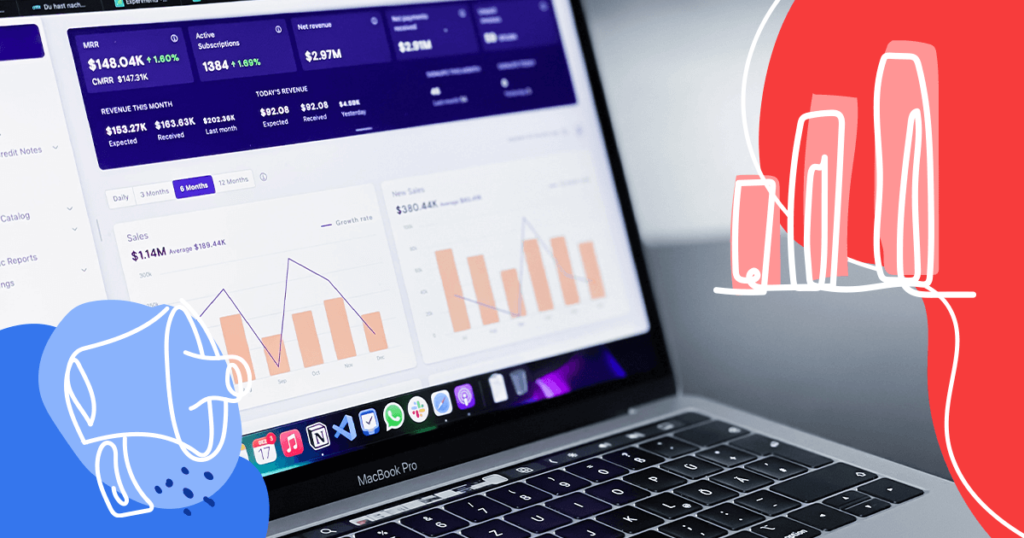In the world of Digital Marketing, one of the most important methods to have emerged over the last decade is data-driven marketing.
This strategy allows brands to reach a target audience on a level that was unheard of before the internet changed the way in which we collect and process data.
No doubt you’ve heard data mentioned in respect to marketing many times.
Perhaps you’re intimidated by the many kinds of data there are or are concerned as to how to integrate data into the more creative aspects of marketing.
But the fact remains that after a decade of exponential growth, data-driven marketing is here to stay, and it can definitely help your company.
So, let’s take a closer look at exactly what data-driven marketing is and examine how it can transform your marketing strategy. In this guide, we will cover the following in depth:
- What Is Data-Driven Marketing?
- Benefits of Data-Driven Marketing
- How to Implement a Data-Driven Strategy
- The Challenges to Achieving Success in Data-Driven Marketing
- How Brands Are Using Data-Driven Marketing
- What Are the Main Data-Driven Marketing Tools?
What Is Data-Driven Marketing?
Put simply, data-driven marketing takes data gathered through customer interactions or acquired from a third party and then uses that information to better understand who a customer is.
This means learning about their preferences, motivations, and behaviors. This data is then used to guide media-buying decisions as well as creative messaging. Data-driven marketing can also point to overall trends.
Data-driven marketing’s main purpose is to create greater marketing efficiency and to enhance the overall customer experience and, of course, achieve a better ROI on marketing channels.
The history of data-driven marketing actually pre-dates the internet. However, the technique grew to prominence with the rise of the internet, with modern day data-driven marketing beginning with customer relationship management software (CRM).
CRMs were what allowed brands to reach out directly to consumers with direct mailings. They made it possible for companies to target their messaging to specific segments of the population.
This early form of data-driven marketing soon entered the world of Digital Marketing when Salesforce ingeniously placed a CRM in the cloud. This paved the way for sales and marketing automation.
This method still made use of some segmentation in sorting customers, but the major contribution it made to data-driven marketing was in creating individual customer marketing profiles based on website and email interactions.
This also led to programmatic advertising (the automatic buying and selling of online ads) being personalized.
This innovative method of marketing, however, created a problem of its own: too much data. Thus, data management platforms (DMPs) were created to manage the influx of so much data.
Now, with more tools than ever before to collect, sort and manage data, there is near limitless potential for personalizing marketing, a fact that few marketers are using to full advantage.
Yet personalizing advertising is more important than ever. In a study from five years ago, over 75% of consumers said that having content from brands that feels personally relevant positively impacts their choice to buy.
In other words, brands can’t afford to keep ignoring the full potential of data-driven marketing, especially with 64% of executives agreeing that data-driven marketing is crucial to success.
Benefits of Data-Driven Marketing
Know Where to Buy
It used to be that the most efficient media planning and buying required psychic skills. Algorithms and machine learning are now able to make programmatic buying as effective as possible.
Target the Right Audience
Data-driven marketing enables specific ad campaigns and messaging to be targeted to specific audiences and can even target specific individuals in personalized marketing based on a customer profile.
Create the Most Relevant Content
Data-driven marketing makes it possible to create content that is aimed at specific segments of the customer base.
Provide a Better Customer Experience
A good customer experience will convert leads into sales and new customers into returning ones.
Take Advantage of a Multi-Channel Experience
The latest technology makes it so much easier to apply data to create a personalized experience across a wide variety of platforms.
Reach your audience on their terms, going beyond direct emails to social media and beyond.
Make a Better Product
Companies can even use data to help improve a product based on customers’ preferences and needs.
Increase the ROI
All of these benefits increase the marketing ROI overall. It’s also important to note that failure to take full advantage of data-driven marketing means being left behind.
How to Implement a Data-Driven Strategy
Here are the six steps involved in implementing a data-driven strategy.
1. Analyze
Before you get started, it’s critical to decide precisely what your goals are with a data-driven marketing strategy. That will allow you to determine what kind of data you will need.
To create individualized customer profiles, you will need consumer information, while if your goal is to better understand the customer journey, you will need to make attribution data your priority.
Once you’ve established your goals, you can work with data scientists to find out what data is missing.
Along with setting goals, also create key performance indicators (KPIs), so you can measure how effective you are at achieving your goals.
2. Automate
It can be difficult to fully integrate data-driven marketing into your existing practices. Make it easy by taking this opportunity for marketing automation.
3. Collaborate
It’s not possible to confine data-driven marketing to solely the marketing department. For data-driven marketing to work well, it’s critical that the marketing department works across the organization, sharing information with other teams and departments.
4. Observe
Data-driven marketing isn’t completely new, but it is constantly changing as new technology is being developed. Observe what other brands are doing, see what works and what doesn’t, and pay attention to where trends are headed.
5. Measure
Make sure to keep your KPIs up to date as your marketing goals change, and always watch that your data-driven marketing is meeting your goals. If it’s not, then it’s time to adjust your strategy.
6. Practice Well
Be certain that you are following best practices when it comes to data-driven marketing — we will discuss this point below.
The Challenges to Achieving Success in Data-Driven Marketing
There are also some important aspects to data-driven marketing that you should know about.
Best Practices
If you’re not employing best practices in your data-driven marketing approach, you actually risk making things worse.
In order to achieve this, it’s critical that you are using the right data and have access to complete data. The questions you need to ask about your data include examining it for:
- completeness;
- accuracy;
- timeliness;
- relevance;
- format.
Having access to the right data ensures that you properly know your audience. This is the main foundation on which data-driven marketing is based.
It is also critical that you properly manage your data so as to make the most of it at all times. Finally, it’s important that you are compliant with any relevant laws. No one wants to find themselves in violation of the GDPR.
By being transparent, providing high-value content, and using data correctly, you can succeed at data-driven marketing.
A few other challenges to watch out for include:
Data Silos
The prerequisite for quality data-driven marketing is quality data. All too often we see a lack of cooperation amongst departments all separately trying to gather specific data and not being able to effectively share what they do have.
Integration
If data-driven marketing is not fully integrated into the strategy, then it is unlikely that a marketing department will be able to get back the data that they need to achieve success.
Becoming Invasive
While consumers definitely prefer a personalized experience, they don’t want things to become too much like “Big Brother.”
Make certain that you are providing value for asking consumers to provide personal information, comply with all relevant laws, and remember that transparency can go a long way.
It Isn’t Easy
While so many of us went into marketing for the many creative aspects of the job, using big data can seem overwhelming.
There is still a place for a great deal of creativity, as long as the data usage is properly integrated, which admittedly can easily become complicated.
Make certain to take the time to plan out your data-driven marketing strategy before implementing it and commit to it fully.
How Brands Are Using Data-Driven Marketing
In understanding how data-driven marketing really works, it’s important to take a look at some examples.
Here are a few of the more successful campaigns we’ve seen utilizing data-driven marketing!
Olay at the Super Bowl
While Olay is one of the world’s largest skincare lines, for any company, taking out an ad for the Super Bowl is huge stakes.
Plus, a skincare ad during the Super Bowl isn’t exactly an intuitive choice. But before taking this major risk, the company researched their data, taking a look at what other interests their audience had beyond skincare. By looking at YouTube and Google data, two themes emerged: football and horror movies.
Thus was born the highly successful horror movie themed #olay ad starring Sarah Michelle Geller.

DirecTV on the Move
In a way, cable television was one of the first industries to use data-driven marketing on a large scale, so leave it to satellite TV to come up with a great method of data-driven marketing.
In analyzing their data, they found that one of the most fertile potential markets were people who had recently moved and had not yet signed up for a TV plan.
In fact, they found that those who had recently moved were 20 percent more likely to consider a different option than those who had not.
DirecTV was able to capitalize on this trend by creating a partnership with USPS, allowing them to target those who had recently moved. This is a great example of third-party data being used to drive data-driven marketing.
While the USPS is one of the most reliable sources for third-party data, there are many other sources that have valuable information, some of which are dependent on the industry.
Abreva Goes Younger
The cold sore medication Abreva realized they needed to reach a younger audience.
Previously, much of their marketing efforts were aimed at a 35+ audience, whom they reached through television. However, they found that most people get their first cold sores while a teenager, making this a prime demographic.
However, cold sores are a tricky topic, especially for teens. Abreva solved this hurdle by creating 119 different ads to show on YouTube to targeted individuals based on what they watched, so there was a specific ad for teens watching a make-up tutorial as opposed to teens watching celebrity gossip videos.
This ensured that the ads were geared toward the viewers’ interests. It also saw a 342 percent increase in search interest and a 41 percent increase in ad conversion.

What Are the Main Data-Driven Marketing Tools?
Buzzsumo
This paid tool helps you track your own digital performance while also giving you insight into competitors’.
Buzzsumo is an ideal resource for researching keywords as well as finding trends to help you optimize your own content strategy. The tool lets you track competitors, offering a better understanding of how you stack up.
Hubspot
Offering both a free and paid version, Hubspot, along with Marketo and Pardot, creates an elegant solution for marketing automation. This allows you to do more with the data than ever before.
Google Analytics
Analytics is a free service that provides an in-depth look at your customers’ interactions with your site, from how they got there to what actions they take while there.
Salesforce or Oracle
Salesforce and Oracle are great options for a CRM, this allows you to create a fully-formed customer database.
Data-driven marketing is the future of marketing, having fundamentally changed the way we digitally market. It’s time to make certain that your brand is taking full advantage of this innovative technique.
If you want to learn more about the theme, download now the 4th issue of Rock Content Magazine, on the data-driven pillars!









